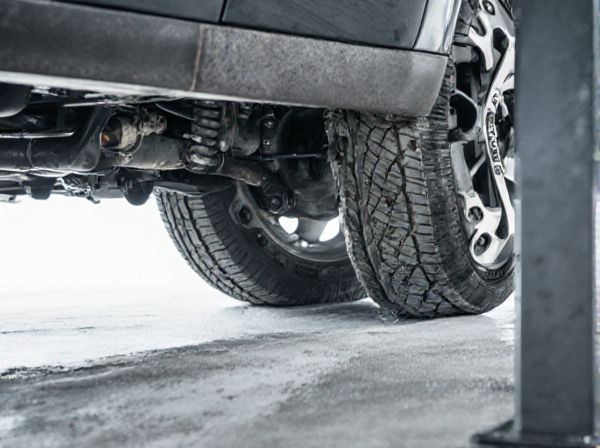
Photo illustration: Selectable Locker vs Automatic Locker
Selectable lockers allow you to manually engage or disengage the locking mechanism, providing control over when the wheels lock for specific driving conditions. Automatic lockers engage and disengage the differential lock based on wheel speed differences without driver input, enhancing traction during off-road or slippery situations. Your choice depends on whether you prioritize manual control or automatic, seamless traction assistance.
Table of Comparison
| Feature | Selectable Locker | Automatic Locker |
|---|---|---|
| Operation | Manually engaged/disengaged by driver | Engages automatically when wheel slip occurs |
| Control | Full driver control | Self-regulating, no driver input needed |
| Use Case | Off-road, when traction is predictably lost | Mixed terrain, unpredictable slip conditions |
| Complexity | Requires additional controls and wiring | Simple, mechanical or electronic trigger |
| Cost | Higher due to manual engagement system | Generally lower, fewer components |
| Reliability | Depends on driver activation, less risk of false engagement | Risk of engagement during normal driving conditions |
| Performance | Optimal traction control when engaged | Fast response to slip, but less predictable |
Introduction to Differential Lockers
Selectable lockers and automatic lockers are two main types of differential lockers used in off-road and performance vehicles to enhance traction by controlling power distribution between wheels. Selectable lockers allow the driver to manually engage or disengage the locking mechanism, providing control over when the differential locks, whereas automatic lockers engage and disengage based on wheel speed differences without driver input. Understanding the operational differences in these lockers is crucial for optimizing vehicle performance in various driving conditions.
Overview of Selectable Lockers
Selectable lockers offer enhanced control by allowing drivers to manually engage or disengage the locking mechanism based on road conditions, improving traction when needed. These lockers provide flexibility for varying terrains, enabling better handling on both paved surfaces and off-road environments. Their design ensures optimal power distribution to wheels, reducing the risk of wheel slip and enhancing vehicle stability.
Overview of Automatic Lockers
Automatic lockers provide enhanced traction by automatically engaging the differential lock when wheel slip is detected, improving vehicle stability and control on challenging terrains. Unlike selectable lockers that require manual activation, automatic lockers operate seamlessly without driver intervention, ensuring continuous optimized power distribution. These lockers are particularly beneficial for off-road vehicles seeking reliable performance and reduced risk of wheel spin.
Key Differences Between Selectable and Automatic Lockers
Selectable lockers allow drivers to manually engage or disengage the locking mechanism, providing control over traction based on driving conditions, whereas automatic lockers function without driver input, locking and unlocking automatically as wheel speed changes. Key differences include driver control, with selectable lockers offering flexibility in activation, and responsiveness, where automatic lockers respond instantly to wheel slip but may cause noise or binding during turns. Selectable lockers generally provide improved drivability and on-road comfort, while automatic lockers excel in off-road traction by automatically distributing torque to the wheel with grip.
Performance Comparison: On-Road and Off-Road
Selectable lockers provide the advantage of engaging only when needed, allowing for improved on-road drivability and reduced tire wear, while offering enhanced traction off-road by locking the axle under challenging conditions. Automatic lockers deliver continuous locked engagement, maximizing off-road performance by ensuring both wheels turn simultaneously for superior grip, but they can cause handling challenges and increased tire wear during on-road driving. Performance-wise, selectable lockers balance versatility between smooth highway driving and rugged terrain, whereas automatic lockers prioritize off-road traction at the expense of daily drivability.
Installation and Maintenance Considerations
Selectable lockers require manual engagement, which simplifies installation by avoiding complex sensors or control systems, making them easier to install in vehicles with minimal modifications. Maintenance demands regular inspection and lubrication of mechanical components to ensure smooth operation, but their simplicity often results in fewer electronic issues compared to automatic lockers. Automatic lockers involve more intricate installation processes due to electronic or pneumatic controls, requiring professional expertise and careful integration; maintenance frequently includes software updates and sensor calibrations in addition to mechanical upkeep.
Cost Analysis: Selectable vs Automatic Locker
Selectable lockers generally incur lower initial costs compared to automatic lockers due to simpler mechanical systems and fewer components. Maintenance expenses for selectable lockers tend to be more affordable, with easier repair processes and fewer specialized parts. In contrast, automatic lockers, while offering advanced functionality and convenience, often require higher upfront investment and ongoing maintenance costs driven by complex electronics and software updates.
Pros and Cons of Selectable Lockers
Selectable lockers offer the advantage of driver-controlled engagement, providing flexibility to switch between open and locked modes for improved traction on demand. These lockers enhance off-road performance by allowing the driver to decide when increased traction is necessary, reducing wear and tear compared to automatic lockers. However, selectable lockers require manual activation, which can be challenging in difficult terrain or distracting for some drivers, and they may require additional maintenance due to their more complex mechanical components.
Pros and Cons of Automatic Lockers
Automatic lockers offer seamless engagement without driver input, enhancing traction and handling in low-traction conditions by distributing torque automatically to the wheels with the most grip. Their main advantage includes improved safety and convenience, especially in changing road environments, while drawbacks involve higher complexity, increased cost, and potential for delayed response compared to selectable lockers. Maintenance can be more challenging due to sensitive electronics or hydraulics, limiting their use in harsh off-road situations where mechanical simplicity is preferred.
Choosing the Right Locker for Your Vehicle
Choosing the right locker for your vehicle depends on your driving needs and terrain conditions. Selectable lockers offer manual engagement for improved traction in challenging off-road situations, providing flexibility, while automatic lockers engage automatically for consistent traction without driver input, ideal for aggressive driving or unpredictable surfaces. Evaluate your typical driving environment and vehicle usage to determine whether control or convenience is more critical for optimal performance.
 caratoz.com
caratoz.com